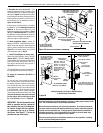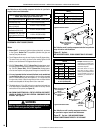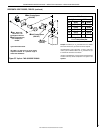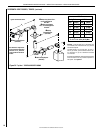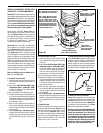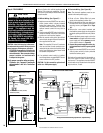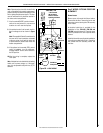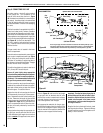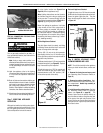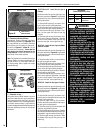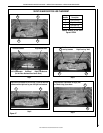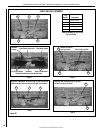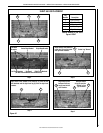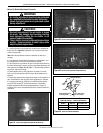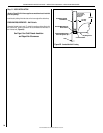
27
NOTE: DIAGRAMS & ILLUSTRATIONS ARE NOT TO SCALE.
Turn on gas supply and test for gas leaks, us-
ing a gas leak test solution (also referred to as
bubble leak solution).
Note: Using a soapy water solution is an
effective leak test solution but it is not recom-
mended, because the soap residue that is left
on the pipes/fittings can result in corrosion
over time.
A. Light the appliance (refer to the lighting
instructions label in the control compartment
or in the Care and Operation Instructions
manual).
B. Brush all joints and connections with the gas
leak test solution to check for leaks. If bubbles
are formed, or gas odor is detected, turn the
gas control knob (off/pilot/on) to the “OFF”
position. Either tighten or refasten the leaking
connection, then retest as described above.
C. When the gas lines are tested and leak free, be
sure to rinse off the leak testing solution.
Step 7. VERIFYING APPLIANCE
OPERATION
With gas line installed run initial system check-
out before closing up the front of the unit. Follow
the pilot lighting instructions provided in the
Care and Operation Instructions manual.
WARNING
Never use an open flame to
check for leaks.
Step 8. INSTALL VOLCANIC STONE,
GLOWING EMBERS AND LOGS
NOTE: Turn off all electricity to the appliance
before you install volcanic stone, embers and
logs.
1. Remove the front glass enclosure panel
(see Removing Glass Enclosure Panels on
Page 31).
2. Remove log set box from firebox. Next,
remove embers and volcanic stone from con-
trol compartment. Handle logs carefully to
prevent breakage.
3. Install decorative volcanic stone - Sprinkle
the decorative volcanic stone in a pleasing
pattern (see Figure 45 on page 28). The
volcanic stone should be placed directly on
top of the firebox bottom, along the slope and
to the back at the right and left sides of the
burner. Position any ceramic fiber liners before
placing the stone. Logs can be positioned after
the volcanic stone.
SUPERIOR DIRECT-VENT GAS FIREPLACES • MODELS SLDVT-30/35/40/45 • INSTALLATION INSTRUCTIONS
Figure 44
MILLIVOLT
Thermocouple
Hood Igniter Rod
3/8" Min
(9 mm)
Thermopile
Pilot
Nozzels
For piezo igniter location see Figure 41 on
Page 26 (millivolt appliances only).
Note: Lighting Instructions are also found on
the literature tag tied to the gas piping next
to the gas valve. To access the tag, open the
lower control compartment door (Figure 41 on
Page 26) by pulling the panel forward.
When rst lighting the appliance, it will take
a few minutes for the line to purge itself of
air. Once purging is complete, the pilot and
burner will light and operate as indicated in
the instruction manual. Subsequent lighting
of the appliance will not require such purging.
Inspect the pilot ame (remove logs, if neces-
sary, handling carefully).
Millivolt Appliance Checkout
The pilot flame should be steady, not lifting
or floating. Flame should be blue in color with
traces of orange at the outer edge.
The top 3/8" (10 mm) at the pilot generator
(thermopile) and the top 1/8" minimum (tip)
of the quick drop out thermocouple should be
engulfed in the pilot flame.
The ame should project 1" (25 mm) beyond the
hood at all three ports (see Figure 43). Replace
logs if removed for pilot inspection.
To light the burner; turn “ON” the remote wall
switch and rotate the gas valve control knob
counterclockwise to the “ON” position (“ON”
will be at the top side of the valve).
Electronic Appliance Checkout
To light the burner, turn ‘ON’ the unit mounted
On/Off switch or the optional remote wall switch.
Ensure the igniter lights the pilot. The pilot
flame should engulf the flame rod as shown
in Figure 44.
Figure 43
ELECTRONIC
Pilot
Hood
Sensor
Igniter
Length Of Pipe With
Attached Shut-Off Valve
Figure 42
TEST ALL CONNECTIONS FOR GAS LEAKS
(FACTORY AND FIELD):



